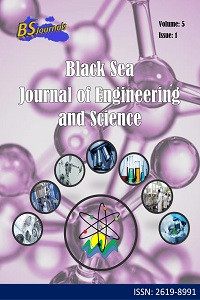Abstract
In this study, the mode shapes and natural frequencies of the horns with different geometries are to reveal an important aspect of the design by using FEM based ANSYS software. Modal analysis of flat horn, conical horn, Bezier type horn and sonotrode type horn profile for four different horn materials was performed using finite element based ANSYS software. Plain carbon steel, stainless steel, aluminum and titanium were selected as horn material in the analysis. It has been observed that different frequencies are observed in different mode shapes and our desired frequencies are the mode in which we have a resonance longitudinal vibration mode. For industrial application, it can find suitable material selection for ultrasonic machine in a certain frequency range. When the obtained results are examined, one can select the appropriate material, suitable size and suitable shape for a particular industrial ultrasonic machine application.
Keywords
Ultrasonic machining Finite element analysis Ultrasonic horn Modal analysis Frequency Resonance length
References
- Amin SG, Ahmed MHM, Youssef HA. 1995. Computer-aided design of acoustic horns for ultrasonic machining using finite-element analysis. J Material Proc Tech, 55: 254-260.
- Nad M, Cicmancova L. 2012. The effect of the shape parameters on modal properties of ultrasonic horn design for ultrasonic assisted machining. 8th International DAAAM Baltic Conference, Tallinn-Estonia, April 2012, pp. 57-62.
- Nanu AS, Marinescu NI, Ghiculescu D. 2011. Study on ultrasonic stepped horn geometry design and FEM simulation. Nonconv Tech Rev, 15: 25-30.
- Rawson FF. 1987. High power ultrasonic resonant horns: Part 1 - Basic design concepts: velocity of ultrasound at 20 kHz; effects of material and horn dimensions. Ultrasonics International 87th Conference Proceedings, July, 1987, Oxford, London, pp. 680-685.
- Roy S, Jagadish A. 2017. Design of a circular hollow ultrasonic horn for USM using finite element analysis. Int J Adv Manuf Tech, 93(1): 319-328.
- Seah KHW, Wong YS, Lee LC. 1993. Design of tool holders for ultrasonic machining using FEM. J Material Proc Techn, 37: 801-816.
- Shu KM, Hsieh WH, Yen HS. 2013. On the design and analysis of acoustic horns for ultrasonic welding. Transact Canadian Soc Mech Eng, 37: 905-916.
- Singh DP, Mishraa S. 2016. Modal Analysis for solid and hollow ultrasonic Horns using fem. ELK Asia Pacific J Mech Eng Res, (Special Issue): 268-275.
- Yadava V, Deoghare A. 2008. Design of horn for rotary ultrasonic machining using the finite element method. Int J Adv Manuf Technol, 39: 9-20.
- Youssef HA, El-Hofy H. 2008. Machining technology machine tools and operations. CRC Press, New York, USA, pp. 672.
Abstract
Bu çalışma ile farklı geometrilere sahip boynuzların mod şekilleri ve doğal frekansları FEM tabanlı ANSYS yazılımı kullanılarak analiz edilmiştir. Dört farklı boynuz malzemesi için düz boynuz, konik boynuz, bezier tipi boynuz ve sonotrot tipi boynuz profilinin modal analizi, sonlu eleman tabanlı ANSYS yazılımı kullanılarak gerçekleştirilmiştir. Analizlerde boynuz malzemesi olarak sade karbonlu çelik, paslanmaz çelik, alüminyum ve titanyum seçilmiştir. Farklı mod şekillerinde farklı frekansların gözlemlendiği ve istenen frekanslarımızın rezonans boylamsal titreşim moduna sahip olduğumuz mod olduğu gözlemlenmiştir. Analizle elde edilen frekans aralığı gibi bulgular endüstriyel uygulamada ultrasonik makine için en uygun malzeme, boyut ve şeklin seçimine katkı sağladığı elde edilen sonuçlarla doğrulanmıştır.
Keywords
Ultrasonik İşleme Sonlu elemanlar analizi Ultrasonik boynuz Modal analiz Frekans Rezonans uzunluğu
References
- Amin SG, Ahmed MHM, Youssef HA. 1995. Computer-aided design of acoustic horns for ultrasonic machining using finite-element analysis. J Material Proc Tech, 55: 254-260.
- Nad M, Cicmancova L. 2012. The effect of the shape parameters on modal properties of ultrasonic horn design for ultrasonic assisted machining. 8th International DAAAM Baltic Conference, Tallinn-Estonia, April 2012, pp. 57-62.
- Nanu AS, Marinescu NI, Ghiculescu D. 2011. Study on ultrasonic stepped horn geometry design and FEM simulation. Nonconv Tech Rev, 15: 25-30.
- Rawson FF. 1987. High power ultrasonic resonant horns: Part 1 - Basic design concepts: velocity of ultrasound at 20 kHz; effects of material and horn dimensions. Ultrasonics International 87th Conference Proceedings, July, 1987, Oxford, London, pp. 680-685.
- Roy S, Jagadish A. 2017. Design of a circular hollow ultrasonic horn for USM using finite element analysis. Int J Adv Manuf Tech, 93(1): 319-328.
- Seah KHW, Wong YS, Lee LC. 1993. Design of tool holders for ultrasonic machining using FEM. J Material Proc Techn, 37: 801-816.
- Shu KM, Hsieh WH, Yen HS. 2013. On the design and analysis of acoustic horns for ultrasonic welding. Transact Canadian Soc Mech Eng, 37: 905-916.
- Singh DP, Mishraa S. 2016. Modal Analysis for solid and hollow ultrasonic Horns using fem. ELK Asia Pacific J Mech Eng Res, (Special Issue): 268-275.
- Yadava V, Deoghare A. 2008. Design of horn for rotary ultrasonic machining using the finite element method. Int J Adv Manuf Technol, 39: 9-20.
- Youssef HA, El-Hofy H. 2008. Machining technology machine tools and operations. CRC Press, New York, USA, pp. 672.
Details
| Primary Language | Turkish |
|---|---|
| Subjects | Engineering |
| Journal Section | Research Article |
| Authors | |
| Publication Date | January 1, 2022 |
| Submission Date | September 9, 2021 |
| Acceptance Date | October 8, 2021 |
| Published in Issue | Year 2022 Volume: 5 Issue: 1 |

